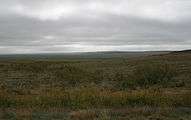XIT Ranch

The XIT Ranch was a cattle ranch in the Texas Panhandle which operated from 1885 to 1912. Comprising over 3,000,000 acres (12,000 km²) of land, it ran for 200 miles (300 km) along the border with New Mexico, varying in width from 20 to 30 miles (30 to 50 km). The massive ranch stretched through ten counties in Texas, and at its peak regularly handled 150,000 head of cattle.
History
In 1879, the 16th Texas Legislature appropriated 3,000,000 acres (12,000 km²) of land to finance a new state capitol.[1] In 1882, in a special legislative session, the 17th Texas Legislature struck a bargain with Charles B. and John V. Farwell of Chicago, Illinois, under which a syndicate led by the Farwells, with mostly British investors, agreed to build a new Texas State Capitol in Austin and to accept the 3,000,000 acres (12,000 km²) of Panhandle land as payment.[2][3][4] The ranch stretched across all or portions of Dallam, Hartley, Oldham, Deaf Smith, Parmer, Castro, Bailey, Lamb, Cochran, and Hockley Counties.[1]
The ranch started operations in 1885, and at its peak averaged handling 150,000 head of cattle within its 1,500 miles (2,400 km) of fencing. The ranch also erected 325 windmills and 100 dams across its land.[1] It covered portions of 10 counties, which apparently helped perpetuate the myth that the brand -XIT- stands for "Ten In Texas." The brand was in fact created to thwart rustlers.[2][1]
The timing for the creation of XIT, however, was bad, as cattle prices crashed in 1886 and 1887. In the fall of 1888, the ranch was unable to sell its cattle and make a profit, and the ranch operated most years thereafter without showing any profit.[1] Also, the cattle were constantly plagued by predators (especially wolves); and the inability to effectively control cattle rustling led to further losses for the ranch.[1]
Operations
The XIT Ranch had a number of rules, including prohibitions against carrying arms; drinking alcohol; and gambling or card playing of any kind.[1] Employees were also not allowed to own any livestock or horses on property, and were not allowed to hunt game with the use of any company holdings, including horses.
Sold off
In 1901, the syndicate that owned the ranch began selling off the land to pay foreign investors as the bonds became due.[1] Much of the surveying of parcels to be sold had been done by W. D. Twichell, then based in Amarillo.
By 1905, most of the land was subdivided, with large tracts being sold to other cattlemen and small amounts of land being sold to farmers. The family of Minnie Lou Bradley, who went on to establish the Bradley 3 Ranch in Childress County east of Amarillo, made large purchases of XIT land. Other purchasers included Texas cattlemen George W. Littlefield, William E. Halsell, and John M. Shelton.[1]
The last of the XIT cattle were sold on November 1, 1912, and land sales subsequently increased.[1]
Legacy
In remembrance of the massive ranch, the City of Dalhart hosts the XIT Museum and the annual XIT Rodeo and Reunion held the first Thursday through Sunday of August. The celebration includes three days of junior and professional (PRCA) rodeo events, the world’s largest free barbecue, three nights of live music, a mud bog competition, an antique tractor-pull, and other activities.
Several businesses in the Dalhart area use "XIT" in their names and styles.
In popular culture
The Charles Ives song, "Charlie Rutlage," is about a poor XIT ranch hand who is killed.
Gallery
-

Display of local brands at the XIT Museum in Dalhart, Texas: Note the XIT brand at the center of the display (2002)
-

Oldham County ranch land in the Canadian River Valley between Vega and Dalhart (2002)
-
Monument in Farwell, Texas, noting the Farwell brothers as receiving the land which became the XIT in exchange for constructing the Texas State Capitol building
References
- 1 2 3 4 5 6 7 8 9 10 XIT Ranch from the Handbook of Texas Online; retrieved April 13, 2005.
- 1 2 Thumbnail History of the XIT Ranch; The XIT Museum website; retrieved March 20, 2009
- ↑ "Fairlawn: The Farwell/McGann Estate at 965 East Deerpath" Biography of Charles B. Farwell; retrieved March 17, 2011
- ↑ History of XIT Ranch; "My Turn;" Hidden Ancestors ; retrieved March 17, 2011
Further reading
- Cordia Sloan Duke and Joe B. Frantz; 6,000 Miles of Fence: Life on the XIT Ranch of Texas; Austin: University of Texas Press; 1961.